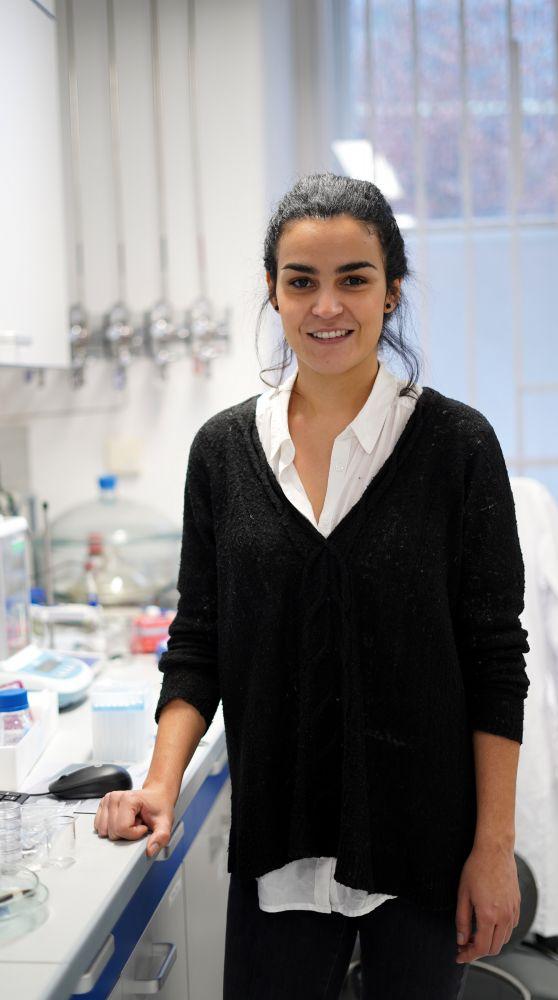
We are trying to test GMO faster
Dr. Lorena Manzanares Palenzuela is the second researcher at UCT Prague to have obtained the prestigious Marie Skłodowska-Curie Individual Fellowship funded from the European framework programme for research and innovation, Horizon 2020. Given the low success rates of applications in this programme, only 25 researchers received this grant in the Czech Republic during the period from 2014 to 2019. Lorena was awarded funding for a two-year long project entitled “Black phosphorus quantum dots as fluorescent nanosensing platforms for detecting unauthorised genetically modified material”.
How did you become interested in research?
I started my research career all the way back in Venezuelan Institute for Scientific Research, where I first became interested in molecular genetics. Molecular biology remained a central topic during my postgraduate studies at Complutense University of Madrid where I later received my PhD.
When you applied for MSCA-IF grant, you were already employed at UCT.
Yes, I met my supervisor, prof. Martin Pumera, at a conference and later I was invited to join his Advanced Functional Nanorobots team at the Department of Inorganic Chemistry at UCT Prague. I especially appreciated the high-end equipment of the Nanorobots laboratories. To apply for MSCA-IF grant, applicant must comply with the “mobility condition”, which means not having spent more than 365 days previous to the application submission in the country where the host institution is located. I applied shortly after my arrival and I succeeded.
Can you describe the context of your research project?
EU is heavily dependent on imports from third countries of vegetable proteins to feed cattle, pigs and poultry, like soya and soymeal. There are many important export countries such as USA, Canada, or Brazil cultivating genetically modified plants. However, in the EU, we honour consumers’ right to choose between GM food and traditionally produced food, hence there are strict rules on the import of genetically modified material containing organisms: authorized products are allowed to enter EU countries but they need to be labelled so that the consumers are well-informed. To ensure enforcement of this rule, regular checks of the imported material need to be carried out. In my project, I study new approach to perform these checks, because the method that is used nowadays is rather slow and expensive.
I guess you are referring to PCR method…
Yes, the Polymerase Chain Reaction (PCR) method. This technique basically uses a small section of DNA to generate a large amount of its copies in vitro. When a DNA sequence of a food product is amplified, it allows for testing of the presence of genetically modified DNA. Although it is a powerful method, it has its drawbacks which can lead to biased results and is quite demanding to perform, which is why only specific laboratories are able to carry out the test.
Can nanomaterials provide better solution?
Nanomaterials show optical and electronic properties that can help to make a difference in the field of DNA detection, so I believe they can. In my research, I focus on emerging materials, and their capacity to serve as efficient DNA-sensing systems to identify the GMO in food and for DNA detection in general.
How does the sensing work?
Basically these materials can act as light switchers in the nanoscale. So by putting a small molecule in the DNA that interacts with the materials often by modulation of their optical properties, we can monitor if the DNA is specific or not for a certain trait, in other words, if it is genetically modified or not, and this can be applied to mutated sequences as well (for example, related to genetic predisposition to certain diseases). So what I am currently working on is investigating these nano-systems for the detection of specific DNA fragments that can be translated to many different applications beyond food control. Nevertheless, the biomedical applications remain very poorly explored.
This brings us to the interdisciplinary character of your research…
The field of nano-biosensors requires interdisciplinary research, which is why it makes sense for me to work in a group experienced in synthesis and characterisation of layered materials. Given my scientific background in pharmacy, my research interests have led her to the topic of genetically modified materials detection, bridging the materials science and molecular biology.
Given that your project is coming to an end soon, how would you reflect on your fellowship?
This project led me to stumble upon very interesting nanomaterial properties for detecting mutations in DNA. So, apart from optimizing these optical systems for genetically modified food, which is a rather complex topic that unfortunately I could not bring to completion, I have also explored the detection of disease-related genes. This has recently expanded my research interests and I’d be excited to continue exploring them. These recent findings will be published soon, along with three other articles that I have already published during this project. But it is not the publications I’m taking as accomplishment from this experience. I have learned plenty, not just scientifically, but also personally by engaging with the group, learning from people and networking abroad as well. Ultimately this is what this fellowship has given me: the opportunity to grow as an independent scientist and as a person.

This article has been supported by project no. LTI17009 (MEYS INTER-INFORM) and project no. 795347 (EU Horizon 2020)







